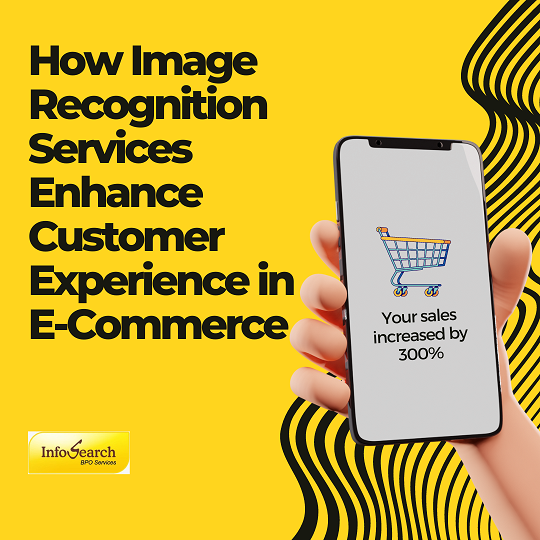Infosearch’s image recognition services enhance the machine learning experience for all industries, especially e-commerce. You can outsource image annotation services along with e-commerce support services to us, and we will help you with both machine learning and customer service.
Image recognition services help to transform the customer experience for e-commerce companies. These tools enable retailers to deliver tailored, effective, and aesthetically pleasing shopping experiences for customers. Here’s how:
- Digital Tools for Product Hunt
How it Works: Customers are able to post the picture of a product they found on the net or in reality and get the same or similar products in the online store.
Benefits:
Does away with the chances of typing in a keyword, which might not give one the right results.
Helps customers engage more with your brand and be satisfied by being shown what they were searching for instantly.
Example: The customer uploads a picture of shoes, and the information submits corresponding products existing in the site.
Impact: Makes the shopping experience easier, and helps avoid obstacles that can hinder the purchasing process, thus increasing conversion.
- Product Recommendation Improvements
How it Works: As opposed to text analysis, image recognition can present more similar products, because it identifies resemblances based on a visual perception of goods.
Benefits:
It is different from recommending products based on purchase history and textual information, but suggesting products based on customers’ visual tastes.
Example: For instance, if a customer admires one product with floral prints, the system recommends other products with the same prints.
Impact: Suggests more products to the customer, more often than not, will recommend products in the same line as the customer’s preference.
- Greater Search Reliability Resulting from Image Tagging
How it Works: There are also several features that we would like to point out here: Image recognition can automatically assign keywords based on the product image.
Benefits:
IT eliminates chances of human interference when manually tagging the products.
Enhances search engine functionality, customer satisfaction by increasing visibility of products and services sought by customers online.
Example: A handbag can be indexed at ‘leather’, ‘black’, or ‘clutch’ so that a customer can easily find the product when searching for it.
Impact: Increases the relevancy of the search results, thus improving the overall ush experience for the end customer, making it easier for him or her to locate products in the store.
- AR Applications in Virtual Try-On
How it Works: With the help of augmented reality, customers can place garments or accessories on their body using only their smart phone, or place furnishings in their living space.
Benefits:
Gives a better customer experience as it is personalized to every individual.
Eliminates risks of returning products because customers feel they have made wrong choices.
Example: A customer is able to see how a given pair of sunglasses would appear to them via their smartphone.
Impact: Becomes a factor of strength to the buyers and a selling tool that will lead to low return rates and thus boost the points of sales.
- Accurate Fraud Checking and Quality Assurance
How it Works: Products can be checked and examined automatically for quality, or counterfeit items can be identified through mismatching images that match a genuine example.
Benefits:
Offends, not the buyers, with what is considered fake goods.
Serve to anchor the building of brand reputation and customer loyalty.
Example: In the course of uploading, merchants’ images of products that they want to sell can be scanned for counterfeit or inferior goods.
Impact: Reduces complaints and returns as customers are confident, they will get just what was advertised and promised to them.
- Improved Customer Services with Competitive Visual Aid
How it Works: Customers can upload images of products they are having problems with (warranty claims, damaged products, etc.), to which the firm responds with an AI generated reply.
Benefits:
Enhances problem solving, decreases conflict in post-sale customer service.
Example: A customer captures an image of a distorted product, and based on the information in the picture, the system handles the claim.
Impact: Ensures customers are happy with the faster and more efficient support processes.
- Inventory Management and Stock Monitoring
How it Works: This technology supports the management in monitoring inventories using images from warehouses or stores to monitor the stock.
Benefits:
Avoids cases of stockouts in businesses due to real-time updates of the available stock.
Example: With the help of cameras and artificial intelligence, monitoring and updating the inventory when articles are either delivered or sold.
Impact: There are implications to aid retailers in managing their inventory to better provide their products to the market’s consumers.
Conclusion:
Digital image recognition software, when integrated within e-commerce-geared companies, provides the retailers with numerous features that shall help enhance customer relations, shopping experiences, and operational procedures. It not only leads to customer satisfaction, but also enables to increase sales and brand identification.
Visit Infosearch’s annotation services page for more information.








Recent Comments